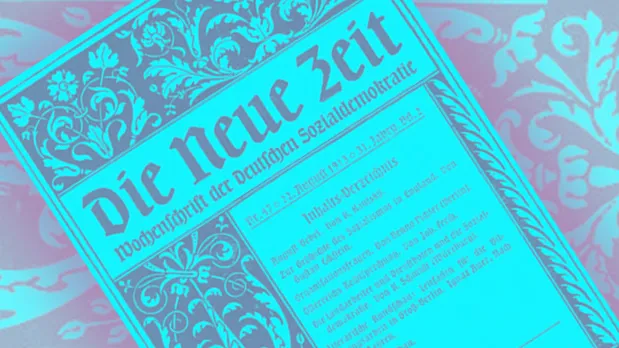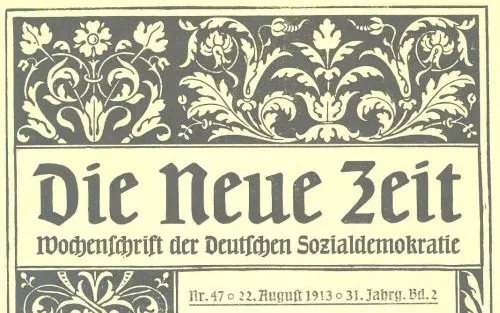Checking in with Ed Baring: Motivation and Lessons behind Citing Marx
6 October 2025

Digital collage of Die Neue Zeit. Credit: Carrie Ruddick
Edward Baring, Professor of History and Human Values, is co-leading an innovative project with the Center for Digital Humanities (CDH) that will transform how scholars understand the circulation and interpretation of Marxist ideas. "Citing Marx" aims to track published citations of the Manifest der Kommunistischen Partei (Communist Manifesto) and Das Kapital (vol. 1) within articles of Die Neue Zeit, a German socialist periodical, focusing on volumes published between 1891 and 1918. With the expertise of the CDH’s humanities research software engineers, computational tools are being developed to identify and analyze how Marx's key works were quoted and interpreted during this crucial period of socialist debate, with a goal to build reusable software for future applications. As the project progresses, we checked in with Baring to learn more about the origins of this collaborative project with CDH. He details the surprising challenges and possibilities of working with research software engineers and how this digital approach relates to his forthcoming book, Vulgar Marxism.
What moment or insight sparked the idea to digitally track citations of Marx's key works in Die Neue Zeit? How does this project build upon your broader research?
A couple of years ago, I was reading State and Revolution (1917), in which Lenin quotes multiple texts by Marx to promote his view about the right way forward for the Bolsheviks in the fall of 1917. I thought to myself that it would be really interesting to know whether these were just random quotes that he had combed through Marx’s texts to find, or whether he was participating in a longer tradition of Marx interpretation. The answer to this question would make a big difference for my understanding of his text. Twenty or thirty years ago, it would have been virtually impossible to answer this question, but I realized that with the right tools, we might be able to do so now. That’s when I approached Natasha at the CDH to start a conversation.
This project involves working closely with Humanities Research Software Engineers at CDH. What has surprised you most about this collaborative process? How has the experience of working with the CDH Research Software Engineers (Rebecca, Laure, Hao) shaped your understanding of what's possible versus what you initially imagined?
It's been a great pleasure working with the talented engineers at the CDH. They have had amazing ideas and have been very helpful. What surprised me was how badly calibrated my expectations were. The tools Rebecca, Laure, and Hao have developed or introduced me to can sometimes do extraordinary things that I would never have thought possible. For instance, it looks like we might be able to develop a tool that can identify Marx citations even in idiosyncratic and one-off translations. That blew my mind. But it is also the case that some seemingly simple problems can be taxing for digital methods, and you quickly recognize the value of working with a team to think through them.
A collaboration with the CDH also includes dedicated project management and project design support. Based on your collaborations with Mary, Jeri, and Ben, what perspective would you share with other researchers embarking on a collaborative humanities research project for the first time?
In the humanities, we really aren’t used to working in large teams, but that has been essential to the project so far. Mary, Jeri, and Ben have helped us work effectively together, making sure that we make progress. But it has been an adjustment for me to learn to use the various digital tools that structure collaborative work today and to fit into its rhythms.
One of the project's key goals is to create a reusable and extensible software package that could work with other journals, languages, and Marx works. As you've seen the pipeline develop, what possibilities are you most excited about for its application beyond Die Neue Zeit? What potential do you see for tools such as this transforming historical research methods?
It would be fantastic if we could expand to journals and books in other languages. In my research, I am very interested in transnational intellectual history. How do ideas travel beyond national borders, and how should we study that? And for these questions, it would be transformative if we could track the history of a particular quotation, compare the “Marx” being cited by intellectuals in different parts of the world, or even return to Marx himself to see which parts of his writings have been picked up by later writers, and which parts have been neglected. We would start to see the tradition with new eyes.
Your new book, Vulgar Marxism, will be released by the University of Chicago Press in December. In what ways does the research that will be enabled through your CDH collaboration connect with this and other earlier work?
Vulgar Marxism follows the development of Marxism on a transnational scale. I look at writings in German, French, Russian, Hungarian, Italian, Spanish, and Dutch. I argue that one of the main things holding Marxism as an intellectual enterprise together in so many countries is a common participation in the project of mass worker education. The research that will be enabled through the CDH would allow me to expand this research. We would be able to see how the ideas and quotations of Marx that were central to thinking through mass worker education were picked up by other figures. It would also allow us to track other types of intellectual connections and thus get a better sense of why and how Marxism came to be such a powerful intellectual force in so many places around the world.
Edward Baring
Professor of History and Human Values

